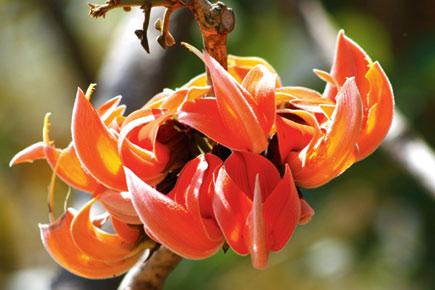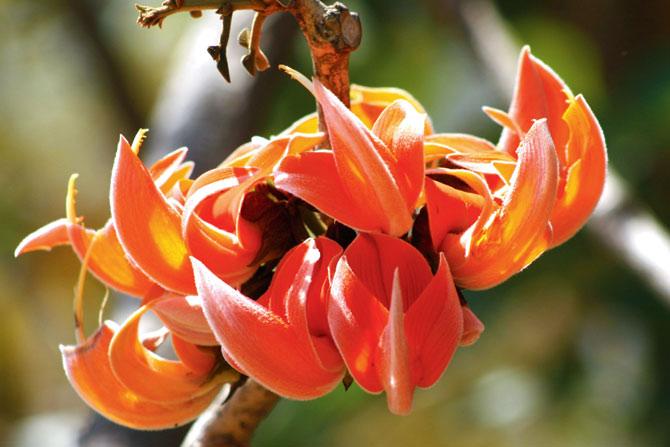I love train journeys. Given a choice of transport between rail, road, air or waterways, I prefer vacations that involve train travels.

Flame of the Forest
 I love train journeys. Given a choice of transport between rail, road, air or waterways, I prefer vacations that involve train travels. But when the issue is about work-based travel, the urgency of travel shifts the gear towards air travel. However, I’m mindful of the carbon footprint involved and the hypocrisy associated with it. Generally my flights rush me to conferences or workshops on climate change, conservation of nature and natural resources. Such is the duality of a modernised and increasingly urbanised life. Personally, I think there is nothing smart about air travel, as it actually takes you far away from the ground and the visual delights that mass surface transport provides.
I love train journeys. Given a choice of transport between rail, road, air or waterways, I prefer vacations that involve train travels. But when the issue is about work-based travel, the urgency of travel shifts the gear towards air travel. However, I’m mindful of the carbon footprint involved and the hypocrisy associated with it. Generally my flights rush me to conferences or workshops on climate change, conservation of nature and natural resources. Such is the duality of a modernised and increasingly urbanised life. Personally, I think there is nothing smart about air travel, as it actually takes you far away from the ground and the visual delights that mass surface transport provides.
ADVERTISEMENT
My passionate and professional travelling takes me to the hinterland of India. And during the recent New Year’s holiday, three of my interns accompanied me to the verdant Konkan region. The visit was a part of our project to document the rare and uncommon wildlife found in the Northern Western Ghats from Gujarat to Goa. Initially, we had hoped to form a group of six to seven people and travel in a hired car, but the smaller number didn’t make it affordable to hire a private car. We immediately made plans to take a passenger train on the Konkan Railway route so as to experience the lush landscape of the Western Ghats. Finding seats in the unreserved train was a terrific experience, as was the bevy of vegetable and snack sellers in the train. Every new station was inundated with fresh passengers and retailers of a new kind. However, for single-minded naturalists like us, the varied scenery was our main focus. Mangalorean tiled houses, wells crowded by women with plastic, aluminium or brass pots, barren paddy fields, drying rivers, mangroves along creeks, lily-filled lakes with waterbirds and of course, the lush hill slopes.

Flame of the Forest
Instinctively, my eyes started scanning for the Flame-of-the forest (Butea frondosa) or Palash trees, which is in blossom now. Generally these trees flower between January and May, depending on which part of India they are growing in. Surprisingly this year we saw the tree in the Maharashtra Nature Park (Dharavi) flower as early as mid-November. Later last week, my walks in the Sanjay Gandhi National Park brought me in the company of some more of these amazing flame-like flowers scattered on the forest floor. The Palash’s three-lobed leaflets are likened to the Hindu trinity of Brahma-Vishnu-Maheshwar. But when the tree is in full blossom with flame shaped flowers, this deciduous tree is almost leafless and is definitely a sight to behold from a distance.
Every part of the Palash tree is deeply ingrained in our culture and rural lifestyle. Sadly, few urbanites attempt to plant these orange-flowered trees in their gardens. Also called Dhak in Madhya Pradesh, most villagers use its powerful wood to make the central pillar of their houses. In Gujarat it is called Tesu or Kesudo and dozens of garbas (songs/poems) have been written, describing the beauty of its flowers, which are dried to be used during the Holi festival. A single dry flower can give deep-yellow colour to a litre of water. These flowers were traditional also used to colour Bandhni or tie-and-die garments. One thing I am very glad for is that it’s become fashionable to use pattals (leaf plates) and dronas (bowls) made from Palash leaves even in Mumbai. If plastic is not used to separate the two layers of the twig-connected leaves, then the plates and bowls can be directly decomposed. One can buy large packets of dhak plates and bowls early morning at the Dadar station.
May be like me, the divine connection of the holy trinity doesn’t allure you to plant these trees. Then, maybe knowing the parakeet’s love of the Palash flowers or the poetry of a garba may convince you that even in today’s jet-speed journey of life, you need a splash of colour, useful leaves, powerful wood and of course, tons of oxygen.
Write in to Anand Pendharkar at sproutsonline@gmail.com
 Subscribe today by clicking the link and stay updated with the latest news!" Click here!
Subscribe today by clicking the link and stay updated with the latest news!" Click here!






